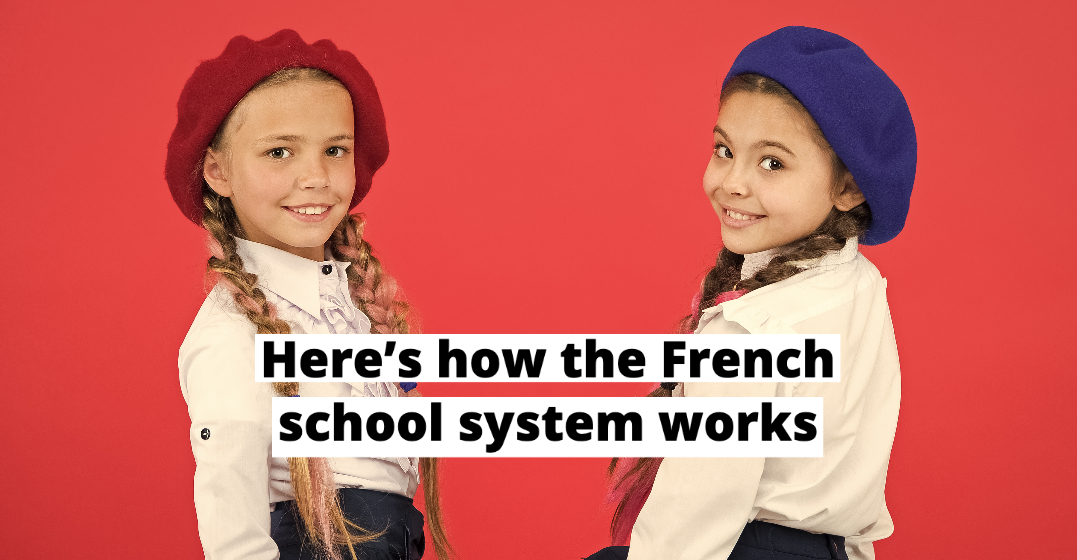Updated on January 8, 2024

How does the French school system work?

In France, education is compulsory for all children, from the age of 3 to 16. Parents may choose to send their child to a school (public or private) or to provide this education themselves. You are moving to France and want to know which school your children should go to? Or you are just interested to know how the French school system works? Then read our article on the French school system explained.
Every child aged 3 must attend school, it became compulsory in 2019. Previously, children didn’t have to attend school until they were 6.
Children in maternelle go through three different classes:
Some schools (depending on the number of students) even offer the TPS (Toute Petite Section) class for children aged 2.
La maternelle is an important step. The French have understood it, that’s why it became compulsory in 2019. The students learn to live together, as well as develop their fine motor skills, letters and sounds in French.
French elementary school children go through five different classes:
Classes from CP to CE2 are the cycle of fundamental learning. During these three years, pupils learn how to read, count and write. In CM1 and CM2 classes, they consolidate their knowledge to be ready to go to secondary school. In elementary school, pupils learn French, math, history, geography, science, sports, music, art and English. French primary schools are managed by the municipality of the town where you live.
The collège allows the pupils to deepen all the knowledge previously acquired. It has four different classes:
The 6ème completes the previous cycle (CM1 and CM2 classes). In 5ème, pupils must choose a second language to learn. Depending on what their first language is, they usually have the choice between English, Spanish or German, or sometimes even Italian (especially for those living near the border). They have other optional choices, for example, they can learn a regional language, such as Breton or Occitan. This time, they have one teacher per subject, instead of having only one per class in Kindergarten and elementary school. The collège is managed by the department in which you live, and teenagers must go to the collège closest to where they live.
At the end of secondary school, students take the national exam Brevet. This diploma attests to the knowledge and skills they have acquired up to that point. From there, students can choose a general, technological or professional path and choose their lycée (high school) according to their specialty.
There are two types of lycée in France: the general and technological one, and the vocational one, where students enter the professional world earlier, alternating working and teaching phases. The names of the classes follow those of the college:
In Seconde, students all follow the same curriculum, whereas in Première, they specialize and choose three specialties amongst 12 (arts, biology-ecology, digital and computer sciences, history-geography, geopolitics and political science, engineering sciences, physics-chemistry, etc.). They keep only two of them in Terminale. At the end of high school, students take the Baccalauréat or Bac in their chosen specialties. Now, the final grade is composed of the continuous assessment (40%) and the final exams (60%). After that, they can enter professional life or go to higher education like university, preparatory classes, business schools, etc.
In France, you have several possibilities after the Bac. We’ll go through them below.
Students are recruited on the basis of a competitive examination, after having passed two years of classes préparatoires aux grandes écoles (CPGE), like khâgne and hypokhâgne for literature studies, for example. These are two very hard years, where you have to study a lot of subjects in an atmosphere of tough competitiveness.
They provide high-level training. Here are some names of renowned schools:
From Kindergarten onwards, you can choose to enroll your children “privately”. Private schools are often Catholic schools, where religion classes are offered, which is not the case in public schools. But they follow the same curriculum as public schools. There are also more and more private schools offering alternative pedagogies such as Montessori or schools based on bilingualism or that are more connected with nature.
When we say “private school” in France, it does not necessarily go hand in hand with “expensive”. Sure, they are not free like public schools, but they are not extortionate either, as some independent schools in England, for example. Prices usually are between 300 and 500 euros per child per year.
After finishing high school and even earlier, students have to think about their future careers. It’s not always easy to decide what they want to do in life. Luckily, there are some steps that help students better understand what they like. First, they should make a list of their skills and interests or pass some orientation test. This helps the students get to know themselves better, their motivations and passions. Once they know what they are good at, they should consider all the options available to them. Visiting some open houses is a good way to get an overview of what the universities and schools are like. They could also contact a career counselor to get more advice on their future path. Finally, students could do an internship in a company to get a real feeling of what it’s like to work in a professional environment.